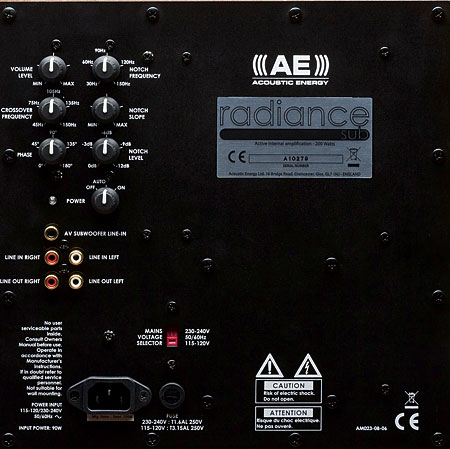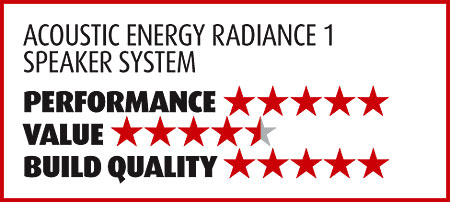Acoustic Energy Radiance 1 Speaker System Page 2

Some subwoofer makers—those reviewed in these pages include Infinity and Mordaunt-Short—supply test CDs and sound pressure level (SPL) meters that are optimized for measuring bass. They encourage users to plot their room responses on a paper graph and adjust accordingly. For this purpose, I recommend the Infinity Room Adaptive Bass Optimization System (R.A.B.O.S.) kit, sold for $60 at www.harmanaudio.com and www.bhphotovideo.com. The measuring process takes about 20 minutes, but when it’s done and you’ve twiddled the knobs in an appropriate manner, you’ll be amazed by how much better your room sounds without a standing wave the size of a whale pounding you every time the subwoofer gets a gob of bass signal.
Associated equipment for this review included a Rotel RSX-1065 AVR and Panasonic DMP-BD55 Blu-ray player. With the exception of one movie selection, I did all of my listening with the sub EQ running.
 Football Players, Robots, Honeymooners
Football Players, Robots, Honeymooners
Oliver Stone’s Any Given Sunday (BD) is a bleak, harrowing, jarring vision of the football business. I knew it would be a rough ride when Al Pacino started yelling his head off 12 minutes into the running time—he usually waits until the last third of a movie. The film starts with an extended action scene that immediately plunged me, via Dolby TrueHD, into a world of dynamic extremes. Thudding impacts alternated with shocking silences, which showed off the Radiance Sub’s controlled impact and transient response. A variety of football-friendly music came through beautifully; the hip-hop and techno beats were powerful, focused, and tuneful. The sub EQ was clearly a resounding success.
Crowd noise was surprisingly muted and panned in a way that suggested its psychological impact on the characters, as opposed to a crowd perspective. To keep the dialogue at an intelligible level, I cranked the master volume higher than usual. This made the playing-field scenes fiercely loud, but the ring-radiator tweeters seemed to love the extra power. They were mercifully devoid of the compressed, crunching, fatiguing characteristics of an overstressed tweeter.
Wall-E (DVD), my token Dolby Digital selection, was the only one that didn’t benefit from the sub EQ—I watched it before I dialed in the notch adjustments for my room. The result was what I usually hear from a decent sub trying to make itself heard through my room’s standing wave. When the spacecraft lifted off, the midbass was strong but muddy, which made me feel like turning it down. Most of the soundtrack consists of mechanical noises, with strings that periodically soar overhead, which is an excellent strategy for a movie of this kind. The Radiance 1 made the noises palatable and filled the boundaries of an agreeably large soundfield with the strings.
The Heartbreak Kid (BD), in Dolby TrueHD, has Ben Stiller flying through marital mayhem as if he’d been shot from a cannon. Whoever picked the soundtrack music was clearly a David Bowie fan. Several classic songs enjoy the benefits of remixing in clean lossless surround—most notably “Suffragette City,” which plays over the end credits. As with most comedies, this one was mixed like a good TV program, so I could watch the whole thing at a low master volume setting without missing any dialogue.
Celebration, Psychedelia, Percussion
André Previn: An 80th Birthday Celebration (CD) is a showcase for the composer, conductor, and jazz pianist, with material from 1961 to 1995. With sterling stereo performance and five matched speakers for Dolby Pro Logic II, I often had a hard time deciding which mode I preferred. They were both satisfying on some level. In stereo, there was so much happening between the speakers that it was rarely advantageous to activate the center channel. Incidentally, that’s a hallmark of a great speaker. But in surround, the soundstage became an equally seamless soundfield, with greater depth, yet without the unevenness that an often ill-conceived hori-
zontal center can impose. Either way, the string sound was natural and so euphonic that even dis-
sonant moments in Previn’s more ambitious compositions were wholesome and nourishing, not cold and harsh. Ideally sculpted midrange performance complemented highs that were fully developed but not edgy or hyped.
Jefferson Airplane’s live album Bless Its Pointed Little Head (LP) documents the band at Fillmore West and East in its glory days, circa 1968. The charismatically loose-limbed performance was unfortunately complemented by some slackness at the mixing desk. Perhaps the biggest casualty was Jack Casady’s barnstorming and texture-rich bass. The Radiance Sub accordingly reflected its reduced status in the mix, but I wondered if a simple sub volume hike would bring it back up to par. With most subs, this is a move I wouldn’t attempt because my room’s standing wave would clobber me. But with a calibrated sub in my arsenal, I took courage and goosed the 200-watt sub’s volume knob to 60 percent of the max (higher than usual for my smallish room). That brought Jack back to life with a roar. The band’s abundance of singers (Grace Slick, Marty Balin, Jorma Kaukonen, Paul Kantner) all got their chances to shine. The Radiance 1 seemed to cherish Slick’s voice, bringing out its typical steely cutting edge and some almost subliminal velvet timbre.
Music for Piano and Drums by Patrick Moraz and Bill Bruford (LP) may be a victim of 1983-vintage digital recording, judging from the blurred bish of the cymbals. But Bruford’s drums thrived in all their restless eloquence—each one precisely tuned, given the ideal measure of impact, and suspended in a three-dimensional space that persisted in stereo or surround. The light, bright piano sound that Moraz favors shared the space, and his glittering glissandos cascaded through the soundstage. There was so much to listen to, I barely noticed the absence of a bass player.
With the Radiance line, Acoustic Energy lives up to its 20-year reputation for making fabulous loudspeakers. Listening to the ring radiator tweeter was a particular pleasure. If you find your current speakers harsh, but you don’t want to give up extended frequency response, you may love the Radiance 1 (and its Radiance kin). The Radiance Sub delivers the benefits of in-room EQ in spades. It’s like waking up from a bad dream—oh, so that’s what bass is supposed to sound like! These are great speakers and overachievers in their price range. Try them, and you may fall in love.





























































